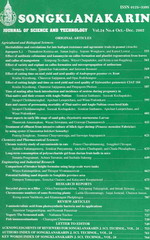ThaiScience
ThaiScience
SONGKLANAKARIN JOURNAL OF SCIENCE & TECHNOLOGY
Volume 42, No. 01, Month JANUARY, Year 2020, Pages 188 - 195
Improving telmisartan mechanical properties through the formation of telmisartan and oxalic acid co-crystal by slow evaporation and ultrasound assisted co-crystallization from solution methods
Hestiary Ratih, Jessie Sofia Pamudji, Fikri Alatas, Sundani Nurono Soewandhi Mohammed Mohammed El GenidyHestiary Ratih, Jessie Sofia Pamudji, Fikri Alatas, Sundani Nurono Soewandhi
Abstract Download PDF
Telmisartan (TMS) is used for the prevention and treatment of hypertension. However, it has poor mechanical properties. The purpose of this research was to improve the mechanical properties of TMS through the formation of co-crystal TMS with oxalic acid (OXA) and to compare the mechanical properties of TMS-OXA 1:1 co-crystal obtained from the different co-crystallization techniques. Co-crystals were prepared by the slow evaporation (SE) and ultrasound assisted co-crystallization from solution (USSC) methods. The tabletability profiles were plotted between compaction forces in the range of 4.98‒29.89 kN vs. tensile strength. The tablet tensile strength of TMS in compaction force >14.98 kN had severe capping or lamination. In contrast, the tablet tensile strengths of the TMS-OXA SE and USSC co-crystals were higher and could be easily formed into tablets in all of the compaction forces. It can be concluded that the TMS-OXA co-crystals prepared by the SE and USSC methods have improved mechanical properties of the telmisartan tablet.
Keywords
telmisartan, oxalic acid, co-crystal, slow evaporation, ultrasound assisted co-crystallization from solutionSONGKLANAKARIN JOURNAL OF SCIENCE & TECHNOLOGY
Published by : Prince of Songkla University
Contributions welcome at : http://rdo.psu.ac.th
